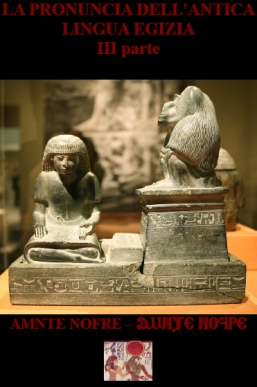EGYPTIAN LANGUAGE: PHONETIC SYSTEM AND PRONUNCIATION
The conventional pronunciation of the Egyptian language, as it is written at the beginning of every grammar of hieroglyphs, is simply a conventional reading invented by the scholars (the “e” between the consonants and the reading of the glides, like the “3” and the “w”, as fixed vowels, as it is for example for “Netjer/Netjeru” and for the names of the Gods such as ‘Heru’, ‘Aset’, ‘Djehuty’ and so on), and it does not reflect the real pronunciation of the Egyptian language: only thanks to the Coptic and to the transliteration of Egyptian words in other languages it is possible to know and reconstruct the real pronunciation of the Egyptian language, and this is exactly our line of research.
To give you some examples,
– Nṯr , “God”, is pronounced “Noute” (in Upper Egypt)/ “Nouti” (in Lower Egypt)
– Nṯr.t , “Goddess”, is pronounced “Entóre” (in Upper Egypt)/ “Enthóri” (in Lower Egypt)
– Nṯr.w , “Gods”, is pronunced “Entèr” (in Upper Egypt)/”Enthèr” (in Lower Egypt)
– Ḥr(w) , “Horus”, is pronounced “Hór”
– Km.t , “Egypt” (literally the “Black Land”), is pronounced “Kéme” (in Upper Egypt)/”Chémi” (in Lower Egypt)
The first part of the study
“Egyptian Language: phonetic system and pronunciation”
dedicated to the study and reconstruction of the phonetic system and the pronunciation of the Ancient Egyptian language.
(click on the image to open the link)
https://www.academia.edu/8123139/Egyptian_Language_phonetic_system_and_pronunciation_-_part_I
Contents:
-Introduction
-Introduction to the Egyptian: stages of the language, the writing systems, and the Coptic
-The Coptic alphabet and the pronunciation of the letters
-The pronunciation of consonants
The second part of the study
“Egyptian Language: phonetic system and pronunciation”
dedicated to the study and reconstruction of the phonetic system and the pronunciation of the Ancient Egyptian language.
(click on the image to open the link)
https://www.academia.edu/11675098/Egyptian_Language_phonetic_system_and_pronunciation_-_part_II
Contents:
1- Syllables and stress
2- The Formative Vowels and the Auxiliary Vowels, the basic rules of the vowel system of the Egyptian Language
3- The theories about the syllables
4- The three states of the words
La prima parte dello studio
“La Pronuncia della Lingua Egizia”
dedicato alla ricostruzione della pronuncia e del sistema fonetico della Lingua Egizia.
(cliccare sull’immagine per aprire il link)
http://www.academia.edu/6911595/La_pronuncia_dell_antica_lingua_egizia_-_I_parte
Indice:
– Introduzione
– Introduzione all’Egiziano: fasi del linguaggio, sistemi di scrittura, e il Copto
– L’ Alfabeto copto e la pronuncia delle lettere
– La Pronuncia delle Consonanti
La seconda parte dello studio
“La Pronuncia della Lingua Egizia”
(cliccare sull’immagine per aprire il link)
https://www.academia.edu/7188836/La_pronuncia_dellantica_lingua_egizia_-_II_parte
Indice:
– Sillabe e Accento
– Le Vocali Formative e le Vocali Ausiliarie, le regole di base del sistema vocalico della Lingua
Egizia
– Le teorie sulle sillabe
– I tre stati delle parole
La terza parte dello studio
“La Pronuncia della Lingua Egizia”.
L’argomento di questa terza parte sono le semiconsonanti 3 , j , y , w , ˁ
(cliccare sull’immagine per aprire il link)
https://www.academia.edu/10197691/La_pronuncia_dellantica_lingua_egizia_-_III_parte
INDICE
1- Le quattro semiconsonanti 3 , j , y , e w
1.a- Mutamenti nella scrittura risalenti al Medio Regno
1.b- Pronuncia e mutamenti fonetici:
– j, y, 3, w che precedono direttamente la vocale accentuata
– j, y, 3, w che seguono direttamente la vocale accentuata
– gruppo di semiconsonanti (j, y, 3, w) che seguono direttamente la vocale accentuata
– j, y, 3, w in posizione pretonica
– j, y, 3, w in posizione post-tonica
– Valore consonantico di 3
2- La semiconsonante ˁ
2.a- Pronuncia e mutamenti fonetici
2.b- Mutamenti vocalici causati dalla semiconsonante ˁ






